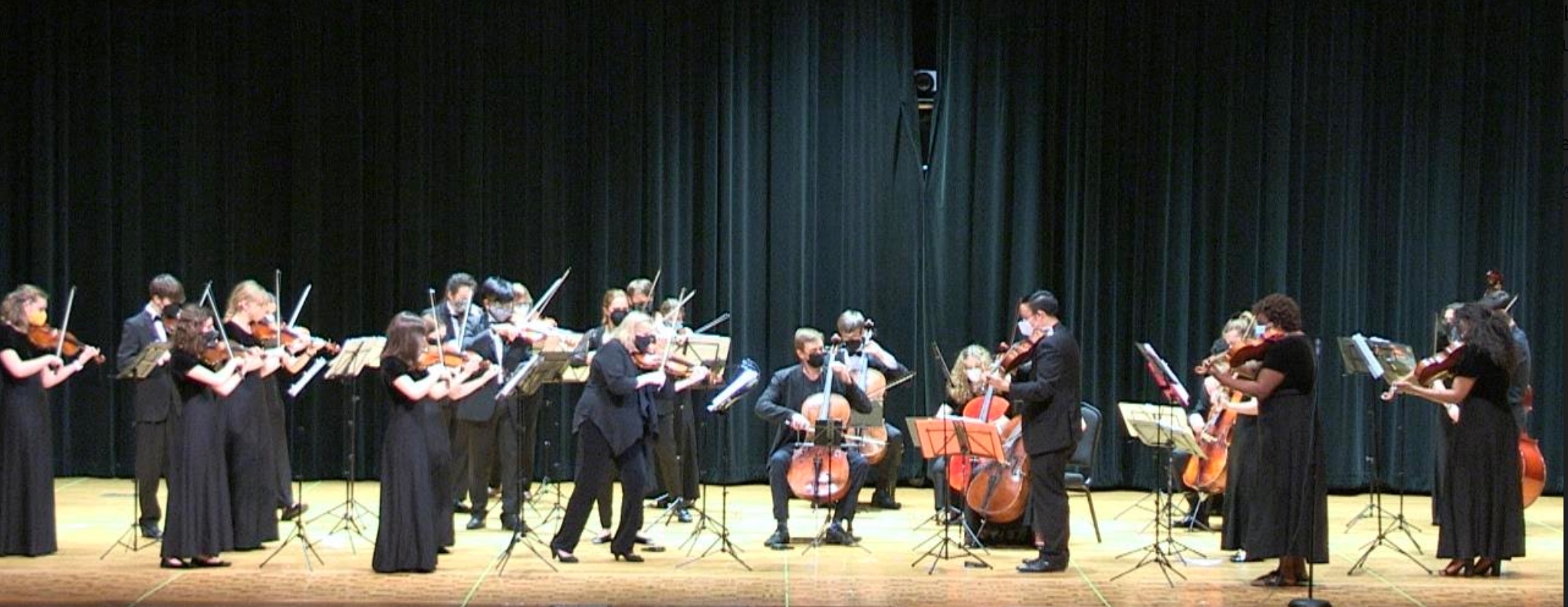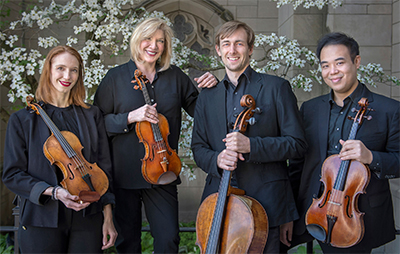by Mike Telin

Programs that have faced extreme obstacles are the junior high, high school, and city youth orchestras — how do you keep students engaged in performance-focused programs when their reasons for existing have been put on hold?
During the recently completed academic year, the Lakewood High School Orchestra program and the Cavani String Quartet partnered for the inspired, interdisciplinary Visiting Artist Project. Using chamber music — Shostakovich’s Quartet No. 8 and Daniel Bernard Roumain’s Kompa Variations — as a catalyst for expression and team-building, the Project also provided an opportunity to talk in general about the impact of the pandemic on high school age students. Although an in-person performance was not a certainty for the duration of the project, ultimately one did take place in front of a live audience in April.
During a Zoom conversation in the fall, Lakewood High School orchestra director Dr. Elizabeth Hankins explained that the gestation of the project began when the Ohio Music Education Association asked the Lakewood music teachers to create a plan for learning during the pandemic. One person Hankins turned to for advice was Annie Fullard of the Cavani String Quartet.
“When talking to Annie, I told her that I needed to find a way to create a healthy place for students to express their emotions and for them to know that they are not alone,” Hankins said. Fullard immediately suggested chamber music.

During that same conversation Fullard said that “chamber music at its best is about connection, empathy, conversation, so for the students — even if they’re just on Zoom — having to be responsible for learning a part and contributing to a greater whole — that can really help with social development. It gives you a reason to do something that is also fun.”
I had the opportunity of being a “silent observer,” for a handful of the 8:00 am sessions — what I witnessed was impressive. I later had the privilege of meeting via Zoom with four students to talk about their impressions of the Project. (The responses have been condensed and edited for clarity.)

Lydia Kress (viola): I think it has really given me the chance to appreciate chamber music in a way that you could never have had had you not been in this kind of situation where you have quartet coachings and where you have these pieces that might not be accessible to you without the help of an instructor.
Mohamed Manaa (cello): I never thought that I would be playing music like this and now I am, and it’s because of people like Dr. Hankins and the Cavani that have really helped us learn and grow in such a short amount of time.
Tovi Vega (violin): Being away from an actual playing environment, I’ve had a lot more freedom to explore, and to think about practice methods and refine what I was doing — like playing two measures super slow for an hour and getting nothing out of it. Now I can actually have a productive 40 minutes.
Arturo Orso (violin/composer): I think it’s really remarkable that we have access to these incredible musicians who are keeping us on our toes. On a personal note, I was able to have them play one of my compositions, which was really impactful for me. The quartet members are really generous with their time and that means a lot to me and to everybody else.
MT: How has the interdisciplinary approach helped expand your knowledge of art, world history, and politics?
Lydia Kress: For me music has always just been music — it’s separate from art and it’s separate from history. I have never been a politics person and I have never been a history person. But this music has submerged me into fields that I never had a lot of interest in or maybe was afraid to explore.
Arturo Orso: I have always loved history and politics. And although we haven’t really covered a lot of modern Russian history in our school classes, I’m sure everybody in this room has done their own research on the communism of that time. But the politics got me more invested — I went back and read a lot of the stories behind the making of Shostakovich’s quartet.
Mohamed Manaa: I never thought that we would mix politics and history with music. Ever since I started the cello in the fifth grade, all the music we played was by white guys, you know, Mozart, Tchaikovsky, Prokofiev — there was nobody that really represented anybody else, and that creates the stereotype that the only famous composers that have intelligence and talent have one skin color. So when we were introduced to DBR (Daniel Bernard Roumain), simply by him being there, it felt right.
Lydia Kress: I was used to getting a piece and practicing it and not understanding what it meant. But once I knew the history, I felt it in my body movements and breathing — it goes beyond just putting your bow on the instrument.
MT: There’s more than just putting the metronome on and playing all the notes at the right time. Of course that’s important, but it’s only the beginning.
Tovi Vega: Yeah, a giant part of playing is the technical part — getting the notes correct — but I think the other half is understanding the composer’s intentions and the conditions under which they wrote the piece. What are the emotions that Shostakovich was feeling? There’s a lot of anxiety and dread — like am I gonna live to see another day or am I literally going to get disappeared.
Mohamed Manaa: I love how we emphasize the history — we never really discussed the lives of the composers and what motivated them to write, but for the first time, I’m really feeling a connection, I’m feeling how I’m supposed to play the notes. There’s this part that’s supposed to emulate gunshots and if I didn’t understand the context or the situation that Shostakovich was living in, I would have just played it like a laptop noise.
MT: How has the project helped you get through these difficult times?
Mohamed Manaa: There’s a lot of anxiety in the world right now — people are angry, they’re confused, and they’re upset. They understand that it’s important to stay inside but when you stay inside long enough, you’re going to start to see the side effects. I think even though it’s not the same situation Shostakovich was living in, you can relate to having to stay inside and being paranoid. I think that by playing something by someone who’s feeling those same emotions it kind of helps. It’s kind of like therapy and I think that’s what’s really so amazing from this experience.
Arturo Orso: I’m trying to do my best to keep some sense of mental health, whether through violin or through meditation. I have a friend who’s a pianist, and when we play piano together it fills my battery for the next month. But on the other side of the coin, I think certainly musicians, and the entire art world will come out of this experience with a lot of important material because suffering, loneliness, and strong emotions always make for good art.
And for me, I got a lot of happiness just by watching Cavani play my music. But nonetheless, it is these strong emotions that we’re all feeling that are going to be a point of reference when other generations have an experience like this. We will have that voice of experience just like people in the 1940s had that experience.
MT: And what excites the teachers about the project?
Catherine Cosbey (second violin, CSQ): This may be an unintended excitement, but it’s awfully lovely to show up at 8:00 am and spend a little bit of time with this music and with these really lovely humans who want to learn. They’re really engaged and we’re learning together and coping together. I feel like we formed this little sort of family.
Kyle Price (cello, CSQ): Being able to play an incredible piece like Shostakovich’s eighth string quartet is so fitting for this rather bleak time. And I think that the students can identify with the piece — there’s a cathartic element to the work.
It’s also acknowledging their own progress as musicians — playing one of the most difficult pieces of chamber music is now pretty comfortable for them. As a public high school orchestra, it shows what students are capable of, given the time to focus and the time to think about how they want to express themselves.
Eric Wong (viola, CSQ): This has been a unique way of teaching because we can’t be in the same room. We can’t really hear each other and it’s hard to demonstrate things like fingerings. So finding ways around that has been quite illuminating. But the thing that has surprised me is how much the students are learning from each other. They all have different strengths and I think that inspires them. I see their growth and their bonding with each other, which is super cool.
Vince Huzicka (violist, Lakewood Schools Orchestra director): All of the things people have said excite me too, but the amazing thing that I’ve taken out of this is just how resilient the kids have been and how we’re getting a new perspective of them and their learning process. The kids are buying into what we’re doing and they’re taking it and running with it. And it’s very obvious how excited they are to be waking up this early and coming to Zoom and play music.
Annie Fullard (first violin, CSQ): I think that as a Quartet, we are the ones who feel really lucky that this took place. At the beginning of the school year Dr. Hankins said, ‘Well, do you still want to do this,’ and I said yes, we’ll figure something out. When you do a project like this, it always turns into something much bigger and more important than you originally planned. And the students, as always, are teaching us.
***
The teaching techniques used in the project are outlined in Fullard’s new book The Art of Collaboration: A Comprehensive Guide to Chamber Music Rehearsal Techniques and Team Building.
Published on ClevelandClassical.com May 26, 2021.
Click here for a printable copy of this article



